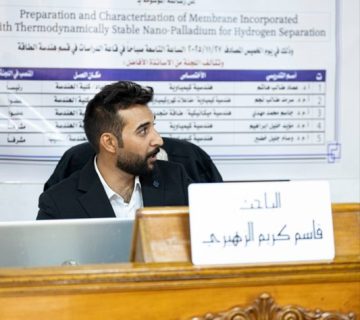Environmental Engineering Department at the College of Engineering, University of Baghdad, held MSc Thesis examination on Wednesday 14\2\2024 titled:
“An experimental study of mitigating the sand erosion dunes by plant enzymatic -induced carbonate precipitation”
By the student Sara Salman Kurdy and supervised by Prof. Dr. Muhaned J.
Mohamed-Ridah. The examination committee consisted of Prof. Dr. Abeer I.
Musa as Chairman, and the membership of Asst. Prof. Dr. Haidar M.
Abdulhameed, and Asst. Prof. Dr. Salman H. Abbas. After conducting the public
discussion and listening to the student’s defense, the dissertation was accepted
with excellent degree. It was summarized as follows:
Enzyme-induced carbonate precipitation (EICP) is a process that uses urease enzyme extracted from plants as a catalyst to produce calcium carbonate (CaCO3). Under suitable conditions, urease hydrolyzes into ammonia and inorganic carbon, which promotes the precipitation of carbonate minerals. This method is currently considered a promising approach for various engineering applications, including enhancing the compressive strength of silty sand. At first, a study was conducted on 10 different plants to identify the most efficient plant in terms of producing a significant quantity of the urease enzyme. Chickpeas were selected as the plant with the highest enzymatic activity among the ten plants, and it exhibited the greatest productivity of the urease enzyme, measuring 2.75 U/mg protein. The extraction efficiency, expressed as a ratio of 1:10 (weight to volume), was achieved within 15 minutes. Various buffers were employed in the process. The sodium phosphate buffer with a concentration of 0.1M and a pH of 7 was chosen as the optimal extraction buffer. The chickpea seeds exhibited a high level of enzymatic activity at a temperature of 37°C during a 60-minute incubation period. The experimental works were categorised into fuor stages. The initial step involves employing response surface methodology (RSM) to ascertain the best conditions for extracting urease enzyme from chickpea seeds. The findings indicated that chickpea seeds exhibited the enzyme activity (3.99 U/mg protein) when subjected to the optimal extraction conditions: pH 7.99, tris base buffer concentration of 0.2, a duration of 60 minutes, and a ratio of 1:13 (gm:ml). These results demonstrate the excellence of the experimental data. When employing a second-order polynomial model, the projected correlation coefficient (pred. R2) was 0.8477, the adjusted correlation coefficient (adj. R2) was 0.9333, and the correlation values (R2) were 0.9665. This indicates a strong agreement between the anticipated models and experimental data. The second step investigated the urease enzyme’s capacity to generate carbonate via bioprecipitation. During this step, the ideal conditions involved using a solution composed of an initial enzyme/(urea/calcium) solution in a 1:1 ratio, with a concentration of 1.25 M, which is appropriate for the mineral carbonate bioprecipitation process. The approval and characterization of this result were conducted using X-ray diffraction (XRD). The third stage involved performing a series of experiments using the design mixture model tool in the Design-Expert programme. In this stage, the programme generated 25 runs for silty sand, considering three variables: ratio (CaCl2-urea) (1.05-1.25) M, enzyme (20-30) ml, and time (12-14) days. These variables were used to determine the optimal percentages for enhancing the compressive strength of the silty sand. in the fourth stage,Wind experiments were conducted to evaluate the use of a topically applied EICP solution containing plant-derived urease(Chicpeas) to stabilise soil against fugitive dust emission. soils were tested (silty sand) . The most effective variables in controlling the movement of soil particles by wind force were as follows order:
Channel >Time>Enzyme>Wind Speed in the X- direction when the soil was treated by the plant enzyme using response surface methodology (RSM). At the same time, this order was Time>Channel >Enzyme>Wind Speed to minimize dispersion in the Y-direction. Testing on silty sand revealed that the enzyme improved the silty sand’s stability and hardness by 75%.This study demonstrated the outstanding potential of EICP as a natural material with significant economic advantages for future utilisation in various engineering applications.








